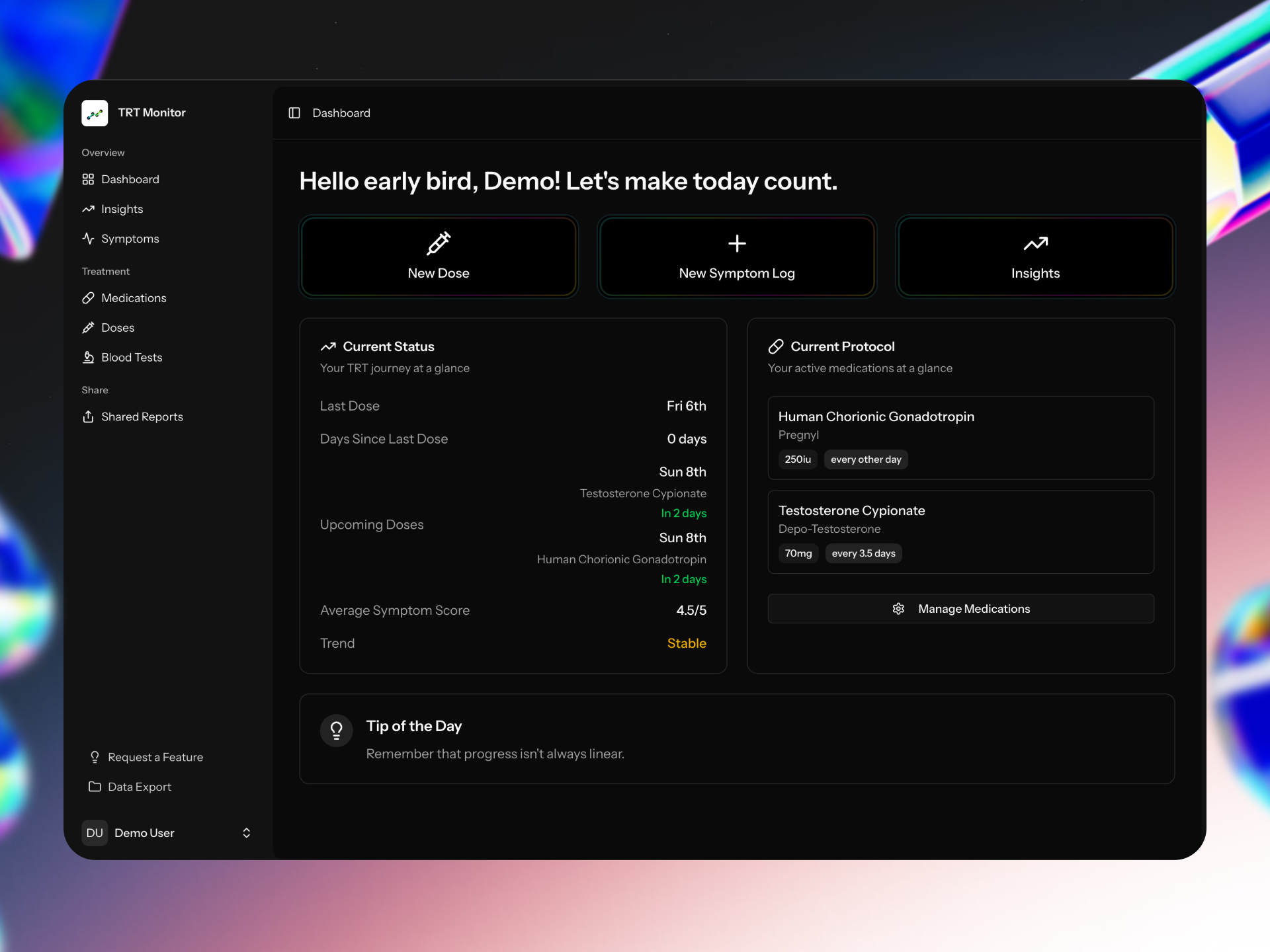Testosterone Replacement Therapy (TRT) isn't a one-size-fits-all treatment. What works well for one person may not be optimal for another. This guide will help you understand how to fine-tune your TRT protocol to achieve the best possible results with minimal side effects.
The Importance of Personalization
Everyone's body responds differently to testosterone. Factors that influence your optimal protocol include:
- Age
- Body composition
- Metabolism
- Sex hormone-binding globulin (SHBG) levels
- Genetic factors
- Pre-existing health conditions
- Treatment goals
Finding your ideal protocol often requires methodical experimentation with careful monitoring of both lab values and symptoms.
Understanding Injection Frequency
Injection frequency significantly impacts how you feel throughout your treatment cycle. Testosterone cypionate, one of the most common forms of injectable testosterone, has a half-life of approximately 8 days (MyFitMed). Injection frequency options include:
Weekly Injections
- Pros: Fewer injections, simpler schedule
- Cons: More pronounced peaks and troughs, potentially more side effects
Twice Weekly Injections
- Pros: More stable levels, often fewer side effects (MyFitMed)
- Cons: More frequent injections, slightly more complex schedule
Every Other Day (EOD)
- Pros: Very stable hormone levels, minimal fluctuations
- Cons: Requires frequent injections, more complex adherence
Research shows that many men find splitting their weekly dose into 2-3 smaller injections helps maintain stable testosterone levels, reducing side effects like mood swings and bloating (ExcelMale).
Finding Your Optimal Dose
The "right" testosterone dose varies widely between individuals. Typical dosages range from 100-200 mg per week, aiming to restore testosterone to mid-normal physiological ranges (e.g., 400-700 ng/dL) as recommended by clinical guidelines (American Family Physician). Your ideal dose depends on:
- Your baseline testosterone levels
- Your body's metabolism and SHBG levels
- Your body's tendency to convert testosterone to estrogen (PubMed)
- Your symptom response
It's advisable to start conservatively and adjust dosage based on lab results and symptom feedback under medical supervision. Remember, increasing dosage isn't always beneficial; sometimes lowering the dose or altering injection frequency yields better results.
Tracking Key Metrics
To effectively optimise your protocol, track these crucial metrics:

Laboratory Values
- Total testosterone (trough levels, measured just before next injection)
- Free testosterone (particularly important if SHBG is abnormal)
- Estradiol (E2), especially if symptomatic (PubMed)
- Hematocrit and hemoglobin (to monitor polycythemia)
- Lipid panel (to monitor cardiovascular risk factors)
- Prostate-specific antigen (PSA)
Subjective Symptoms
- Energy levels
- Mood stability
- Libido
- Sleep quality
- Exercise recovery
- Cognitive function
A structured system like TRT Monitor helps identify patterns and correlations between your protocol adjustments and symptom improvements.
Individual Factors: SHBG and Metabolism
Sex hormone-binding globulin (SHBG) significantly affects testosterone metabolism. Men with lower SHBG may require smaller, more frequent doses to avoid rapid utilization of testosterone and associated fluctuations (ExcelMale). Understanding these individual factors is critical to optimizing your protocol.
The Role of Adjunct Therapies
Some men benefit from additional medications to optimise their TRT experience:
- Aromatase inhibitors (AIs) - May help control estrogen in men with elevated estradiol levels, but should be used cautiously and only when symptomatic (PubMed).
- hCG (human chorionic gonadotropin) - Helps maintain testicular function and fertility, preventing testicular shrinkage associated with TRT (Male Infertility Guide).
- Dihydrotestosterone (DHT) blockers - May be used selectively for hair loss concerns but require careful consideration and monitoring.
Always use adjunct therapies under medical supervision, ensuring they align with your personalized goals and medical needs.
Estradiol Management
Estradiol management deserves brief mention. Men with higher body fat may experience increased aromatization (conversion of testosterone to estradiol), causing symptoms like bloating or mood swings. Strategies such as dose adjustment, increased injection frequency, or targeted weight loss can often help manage estradiol without aggressive intervention (PubMed).
Conclusion
Optimizing your TRT protocol is an ongoing process that may require several adjustments as your body changes and your needs evolve. Be patient and methodical in your approach, making one change at a time and allowing sufficient time to assess effectiveness.
Working closely with a knowledgeable healthcare provider and maintaining detailed records of your symptoms and lab values-like those tracked in TRT Monitor-will ensure your TRT journey is safe, effective, and personally tailored to your unique health goals.
References and Further Reading:
To delve deeper into optimizing your TRT protocol, consider these reputable resources: